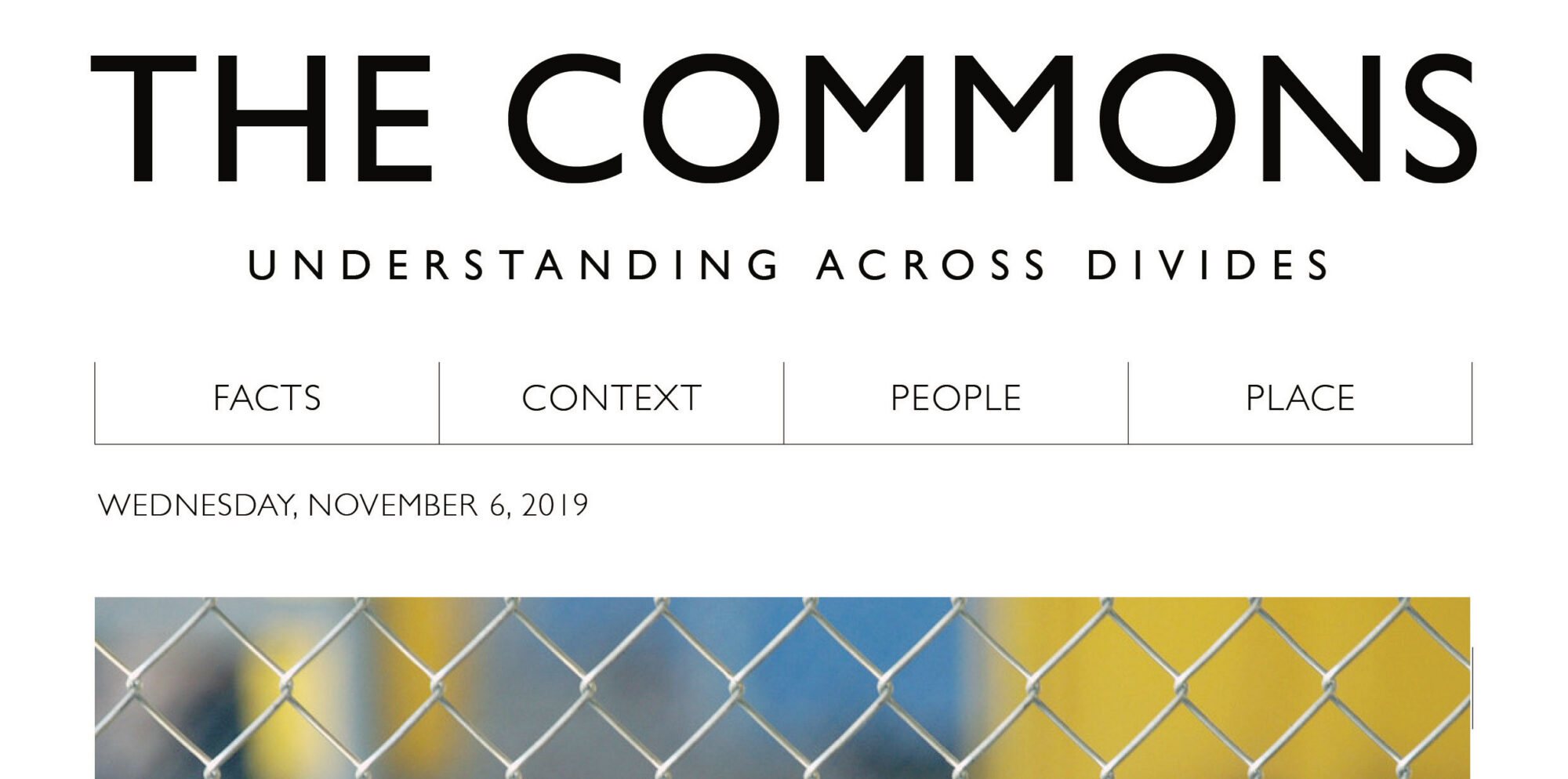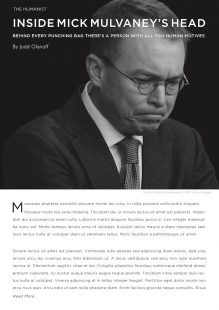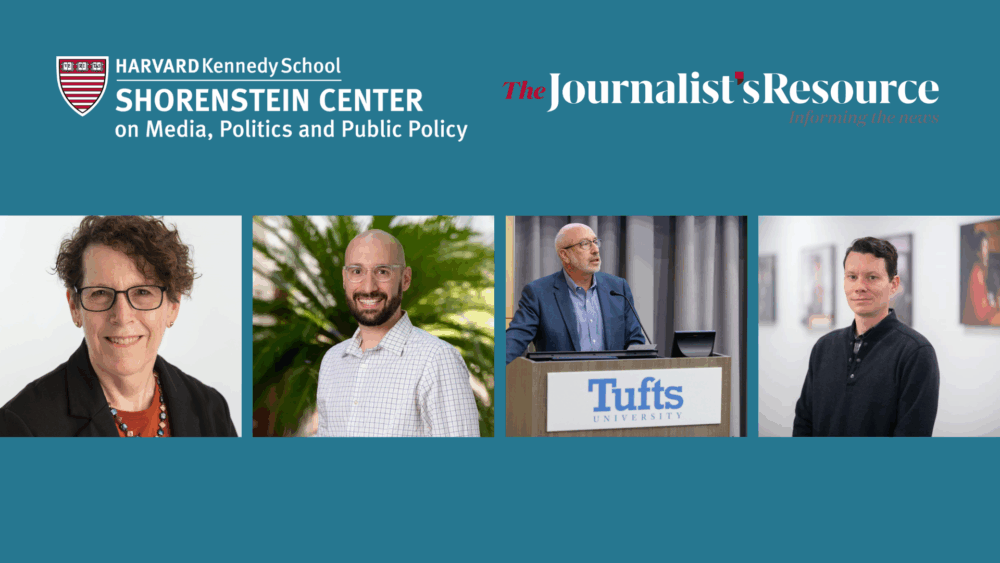
Videos
Regulating Social Media: America’s Global Communications Dilemma
Reports & Papers
Journalism, Media Business Models, Media Creation, Media Standards & Practices

The Commons is a prototype of an imagined news outlet covering U.S. politics. It is the product of an eight-week discussion workshop this fall at Harvard led by Adam Moss, Shorenstein fellow and the former editor-in-chief of New York Magazine and The New York Times Magazine. The workshop’s premise: building a better political media.
Exploring what we think political media could do better, we assembled a long list of problems, including the media’s addiction to conflict, its centrist bias, chronic failures of accuracy or proper context, and short attention span (amplified in the Trump era), to name just a few. Then we examined the incentives driving those tendencies.
We were a group of 14, mostly a mix of Harvard Kennedy School students and Harvard College undergraduates. Exploring what we think political media could do better, we assembled a long list of problems, including the media’s addiction to conflict, its centrist bias, chronic failures of accuracy or proper context, and short attention span (amplified in the Trump era), to name just a few. Then we examined the incentives driving those tendencies. We were helped in this inquiry by a number of professional guests who were kind enough to Skype in to share their own diagnoses. We found ourselves coming back repeatedly to the larger cultural problem, of which media is a symptom (also sometimes a cause): the intense polarization of the population, especially where information is concerned; the lack of civil discourse; the absence of territory where those with different values might come together. We decided to try to address that problem with a ‘platonic’ website which might explicitly try to bridge divides. Secondarily, the site would try to promote empathy and humility, two values lacking in most media (and most corners of the culture). The site’s primary job would be to provide incisive context rather than cover breaking news. In the latter days of the exercise, we also made an effort to try to make the site something people might actually want to read, rather than just deem worthy. The results are below.
A few notes on The Commons: It is meant to stand alone, or, simultaneously, be disaggregated and delivered in pieces by email in newsletter format (the delivery system the group felt was the most effective for its intended audience). It lives on many different platforms – as text, podcast, video – and there’s even a live element. One could “subscribe” to the whole package or to the individual parts and, to the extent that we addressed the business model, it was thought that the site or its parts would be paid for by consumers, but subsidized by philanthropic funders attracted to its civic goals, or sponsored by advertisers also attracted to its bipartisan aims. It is meant to create a community of readers interested in the kind of discourse it promotes. Though it is ostentatiously bipartisan, it is not meant to advance centrist politics (in fact, to the extent possible, it aims to have no discernible politics at all, though the group recognizes of course that that is impossible) – it is more about providing a space where competing values are honored (the phrase “the anti-Twitter” was bandied around; also, a media DMZ).
In addition, the workshop developed a series of other sites we thought worth throwing out there that did not fit the core framework of The Commons. They follow after The Commons below.
We decided to try to address that problem with a ‘platonic’ website which might explicitly try to bridge divides.
An important caveat: these are prototypes – and hardly even that (this was a sprint, an exercise). Nothing is live; nothing is real. In fact, quite a bit of it is completely made up, as prototypes tend to be. We played with time; headlines don’t match the date they really occurred. Bylines belong to the group’s participants.
The site was designed by Paloma Strelitz, a Loeb fellow, and much of the heavy lifting was by Judd Olanoff, a student at Harvard Kennedy School and Stanford Graduate School of Business and the workshop’s research assistant. In addition to the two of them, the workshop’s participants were: Dan Azzi, Isabella Borshoff, Simon Borumand, Derrick Flakoll, Greg Harris, Madeleine Joung, Roman Kay, Heidi Legg, Zoja Surroi, Amy Yee, and Andrew Zucker.
And, finally, these prototypes are just demonstration models. We’re under no illusions that political media’s shortcomings are easily solvable – or that this project solves them. That said, here’s what we came up with.

The site’s title suggests a place for gathering, and defines the publication as the locus of a community. In this case, that community is an audience of people eager to get beyond polarities, listen, learn, and engage in civilized discourse. That doesn’t mean diluting opinions, and it doesn’t necessitate centrism. Polarized opinions are welcome, as long as they’re fact-based, and as long as we listen to each other with open minds. Because the site’s ideals seem so quaint in this moment, we chose a quaint, old-fashioned name.
5Facts presents the top facts of the day, separating them from analysis or interpretation. The facts are selected with an eye not to the ‘biggest news’ as other outlets would define it, but to the facts that we believe should endure beyond the noise of the immediate cycle (hence, not every tweet and Beltway twist and turn, but news that is resonant of significant change). Each fact links to a dispassionate description of what happened and why it’s important.
The facts represent events that have occurred – verifiably and objectively – whose significance is likely agreed upon by people on the left and the right. Beneath each fact are links to contrasting interpretations. These are designed to push readers outside their “bubble” by aggregating opinions that their curated social media feeds likely avoid. Though we know that there is a danger in linking to certain kinds of opinion in the current news environment (provoking outrage without advancing understanding), that risk can be mitigated by linking to opinions that we assess to be grounded in fact. In addition to the five facts, we include one “untruth,” also with contrasting interpretations. The “lie” demonstrates the sometimes-blurred line between fact and falsehood, and the challenge presented when opinions don’t share a set of agreed-upon facts.

The Long View presents a long-form story meant to help readers understand the full context surrounding an item in the news, leaning heavily on history. It is designed to frame an issue by illuminating what it means, exploring its nuances, and considering how we arrived at the present moment.
We also include, in audio form, a conversation with the author about how the story was assembled – why we pursued it, how key interviews developed, and which unexpected challenges were overcome. This audio experience is designed to build trust and familiarity between reader and writer and offer the reader transparency into our methods.

The Humanist attempts to understand a person – who they are, and why they are that way. It’s a profile whose object is empathy, regardless of the subject (empathy but not exoneration).
Often in political media protagonists are reduced to caricatures – heroes and villains, winners and losers. Empathy and complexity are, at times, in short supply. This section aims to serve as a corrective.

Two Governors presents the transcript of a conversation between two U.S. governors from opposing parties about how to solve a problem that matters. They have 30 minutes to grapple with an issue, find common ground, and offer concrete solutions – kind of like a high-minded reality television show. The ground rules would be designed to prevent filibuster, self-aggrandizement, and demagoguery. This section is designed to move beyond soundbites and talking points and to generally promote the arts of negotiation and compromise. It presents an opportunity for citizens to see elected officials engage issues substantively and pragmatically. Highlights are presented in video form. (Note: this idea was inspired by a project Robert Taylor, a Harvard ALI Fellow, is undertaking with mayors as his negotiators).

Return revisits an issue that the media covered intensely and then simply moved on from weeks, months, or years ago. That’s common practice in the 24-hour news cycle: an item generates a flurry of coverage for a day or two, then recedes into obscurity. The passage of time should allow follow-up coverage to present new information, perspective, and context. A video summary supplements the text story.

Reading the Polls presents the latest political polling, but rather than leaving readers with only the conclusion (“Candidate X is up; Candidate Y is down”), we offer explanations for why the poll result is what it is. Perhaps Candidate X’s field operation knocked on more doors this month. Or maybe the candidate’s obsessive focus on a particular policy issue at town halls has finally paid off. We consider all explanations and in some cases report it out. It’s the simple act of explaining the poll at all that could help readers understand the dynamics of the race, and the issues driving the numbers, rather than just seeing candidates as numbers in a one-dimensional, conclusion-only horse-race poll result.

In an era of entrenched tribalism, people change their minds less. I Was Wrong is a platform to address that. It’s a place for leaders (and maybe regular folk too) to explain how they changed their mind on an important subject, and explain why. It’s meant to promote humility, but because it is inherently a narrative (mind changed!) we thought it could be compelling as well.

Reader Panel addresses issues and questions that readers submit. It’s possible they couldn’t care less about impeachment but really care about something closer to home. This is their opportunity to set a different agenda than the one defined by the conventional media (or by The Commons editors). The section is inspired by the Citizens Agenda approach to political coverage, in which news organizations cover issues that readers say they want covered. This model was pioneered by The Charlotte Observer in the 1992 Presidential election and has been championed in recent years by media critics including Jay Rosen of NYU and Margaret Sullivan of The Washington Post. The model attempts to move citizens’ concerns to the center of the discourse.

Technology affects every part of our lives. We’ve reached a point where it’s difficult to function in daily life without it, and yet almost every utopian step forward casts a dystopian shadow. This section explores the profound tensions it creates, in debate style. Should we have political ads on platforms? Where is the regulation headed and does it stifle or enhance the promise of technology? Does it matter if our kids barely explore the outdoors and are constantly connected? What are the benefits of VR? Are we in a surveillance state? How is our privacy being exploited and is the fear all hype or is this a great advancement to realizing our every need? Tech Tensions will serve up two different viewpoints each week around a major influence in technology that is dramatically changing humanity.

Politics of a Place endeavors to understand places and communities – their contradictions, complexities, and unique stories – and thus, like The Humanist above, to promote empathy. The goal is also especially to help bridge the urban/rural divide by guiding readers to consider places in all their depth and nuance – particularly places (and their populations) they might otherwise write off, caricature, or ignore.

In 18 we
explore what leaders were like in their formative years, before the polish set
in on their public image – just as their worldview was being developed.

First Principles is an extravagantly shame-free explainer on an issue the news presumes people understand but often don’t. It patiently walks readers through the facts and context of an issue they may not know about. Often, coverage caught up in the 24-hour cycle seems to assume readers know all the relevant facts that led to this point. This section acknowledges that educating, and offering perspective, are crucial parts of news coverage.

Traveling Town Hall brings The Commons to your neighborhood and gives you an opportunity to meet other members of The Commons community. It is a live panel conversation in front of a general audience in a new place each week. Topics are of general interest, relating to – but transcending – the immediate news cycle. The stable of hosts will be consistent, so readers develop a sense of getting to know them and their sensibilities. In our dream scenario, they’d build cult-like followings. A live audience format could make readers feel part of the conversation and deepen engagement. The hosts would need to be sufficiently charismatic, and the topics sufficiently interesting and entertaining, to entice people to pay and show up. A transcript will be provided, and livestream and podcast formats will be available.

You don’t have to travel to Cambridge, pay tuition, and “get in” to go to Harvard. Veritas would bring Harvard to you. We’ve all been impressed by the teaching here, and find it especially interesting when professors connect their scholarship to current events, explaining why the thing in the news came to be. So we thought there might be an opportunity for lectures as news products – discrete “performances” in the vein of Ted Talks or MasterClasses. In Veritas, Harvard faculty lecture on topics in the news related to their expertise. Some of these might be on evergreen topics, but some might be commissioned in a hurry to address pertinent breaking news.

BS is a central currency of the D.C. swamp. Spin, lies, exaggerations, disingenuousness, canned talking points, shameless self-promotion – they’re everywhere. You can smell it. But sometimes you need help to identify it with precision and mock it (in gentle good humor, of course) for what it is. In BS, we help with that.

The Public Actor views politics through a theatrical lens, analyzing the motives, priorities, and calculations behind each protagonist’s strategy. Our experts deconstruct how public figures arrive at their public stances, how plots play out. How do we understand why they end up saying what they say? Without vilifying or admiring, we examine why they are as they are, much as a theatrical dramaturge would.

Sick of the same old political writers churning out the predictable party line on the same old topics? We’ll cultivate a stable of 10 of the freshest, most dynamic, most enigmatic writers around (the group will refresh routinely), and we’ll “drop” their latest original work into your email box every morning. They’ll write about topics way outside the pull of the news. These pieces will pop like literature. The writers won’t fit in an ideological box; you won’t know in advance where they stand on a particular issue. They’ll spark debate and keep you guessing. You pick which ones you subscribe to.

Anonymous captures the inner rumblings and intrigue inside the hallways of American institutions, campaigns, companies, networks and the like. Inspired by the author of the New York Times anonymous op-ed (and new book ‘A Warning‘) and also the anonymous Ukraine whistle-blower, the site offers inside accounts by moles, who our editors have sought out or who come to us to reveal information or insight. Usually, these are separate individuals, but the site may also occasionally interview several inside sources and cobble together their account under a single Anonymous byline (as, for instance, the extant Spy did when they ran a similar column purporting to record from the inside of the New York Times, CAA and other institutions).
Disclaimer: In many ways, Anonymous is a very irresponsible idea, susceptible as it is to becoming a vehicle for grudges and misinformation, at the very least. Anonymous would certainly know the name of the author and it would also make every effort to fact-check the information it published but the very nature of its project would mean that some information would have to rely on the author’s account. Plus, it is exceedingly difficult to pull off, even if one did feel comfortable moving ahead. But, naturally, the group was very interested in the content – or at least as fantasized.

Videos

Videos

Explainers, Podcasts, Videos